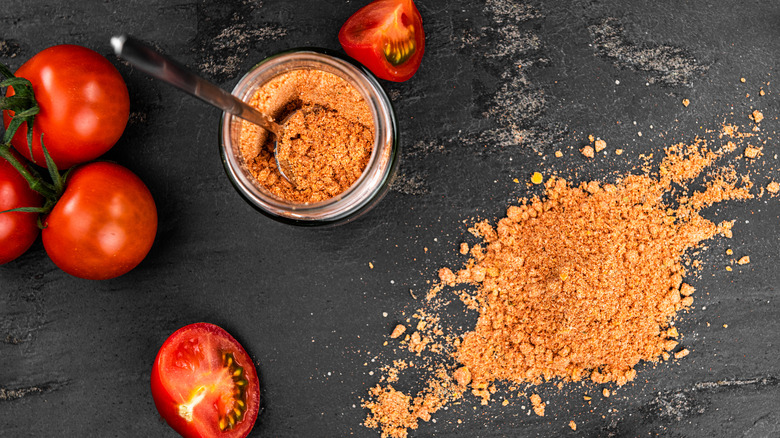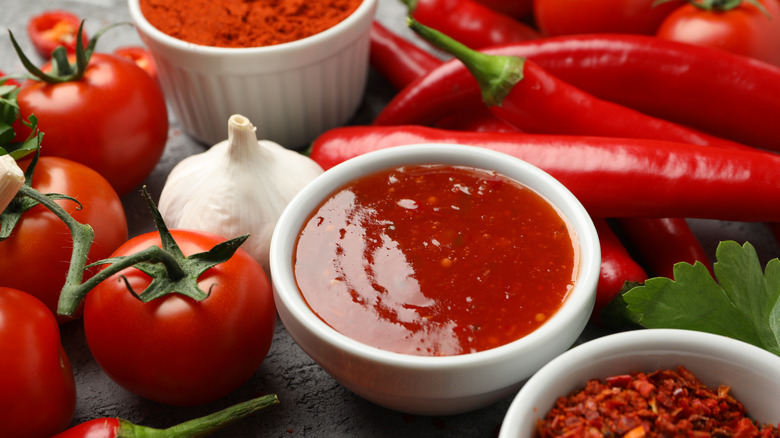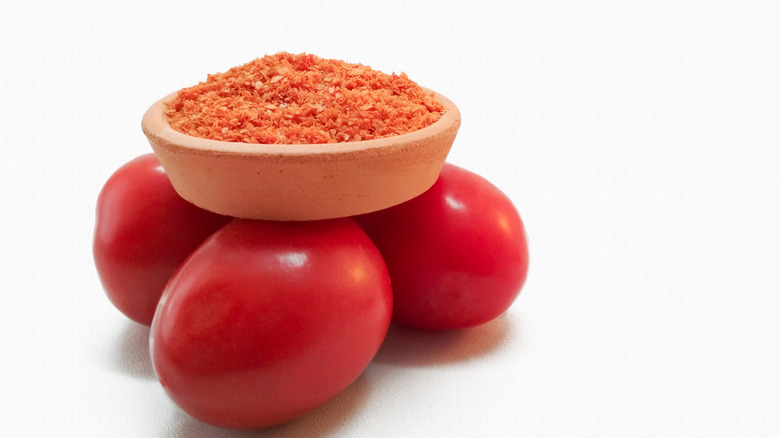Tomato Powder Is The Versatile Spice You Should Have In Your Pantry
From the basic cook to the most experienced chef, one category of ingredients unites them both. Spices bring flavor to any recipe. From simple cracked pepper to extravagant saffron, each offering can add another layer to the mix. Although many cooks have their favorite ingredients that can punch up a recipe, tomato powder might not be at the top of the list. After a little thought, though, it could be the secret sprinkle that amplifies flavors in the most delicious way.
Tomatoes are a staple in many recipes. Although often associated with Italian cuisine, Authentica Cuisine states that tomatoes arrived there from South America via Spanish Conquistadors in the 1500s. As the plant traveled across Europe, the "exotic fruit" eventually became part of tomato sauce and pasta dishes. While its popularity did not take hold until many, many years later, tomatoes, tomato sauce, and a variety of tomato products have long lined the home pantry waiting to be used. From simple to intricate meals, the versatile fruit has a myriad of uses, but tomato powder — while less ordinarily utilized — might be the new ingredient that needs to be added to your spice cabinet.
What is tomato powder and what does it taste like?
Many people are familiar with popular dried spices. Garlic cloves can become garlic powder and cinnamon sticks are ground into cinnamon powder. Turning that juicy tomato into another form is not just a gastro-molecular food trick. According to SPICEography, tomato powder is essentially a dehydrated tomato pulsated into a granular form. The consistency is similar to other finely pulverized spices, like how paprika is made from ground peppers.
As might be expected, tomato powder tends to have a concentrated tomato flavor. It is not about adding heat to a recipe. It is about putting the tomato essence into a dish. When in-season tomatoes may not be available or a more robust tomato flavor is wanted, this spice option is a tasty choice. But, like many spices, proper storage must be considered. According to Delighted Cooking, tomato powder should be stored in an airtight container to avoid clumping. In addition, it is recommended to store this spice in the freezer for optimum flavor retention and to keep it fresher for longer. Even if tomato powder is not the most common spice on the rack, is a clever solution to bring a little more acid and umami to a dish.
What are some ways to use tomato powder?
While many chefs and home cooks have plenty of uses for tomato sauce or tomato paste, tomato powder might not be front and center on the shelf. Although not necessarily a ubiquitous pantry spice, it has a surprising amount of uses. For example, The Spice House recommends using it as a finishing sprinkle over pizza, bread, or even a salad. It could also be used in pasta recipes or almost any dish where tomato flavor needs to be enhanced (perhaps on your next grilled cheese).
In addition, on YouTube, spice brand Knorr suggests using tomato powder in a rub. While the video shows the rub seasoning chicken breast, the bright, acidic tomato flavor combined with other spices could be delightful on pork and other proteins. Also, larger amounts of the powder can be reconstituted with water to make a paste (per Harmony House Foods), which can then be employed to thicken soups, stews, gumbos, or other sauces.
If you find that something's missing when organizing the spice cabinet, adding a container of tomato powder might be a good idea. It's yet another way to enjoy the complex, robust flavors of this popular fruit and add some zip to any kitchen creation.


